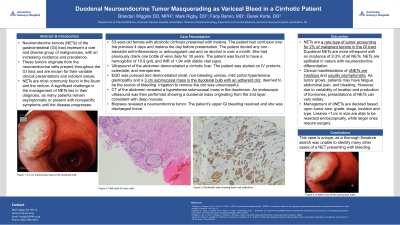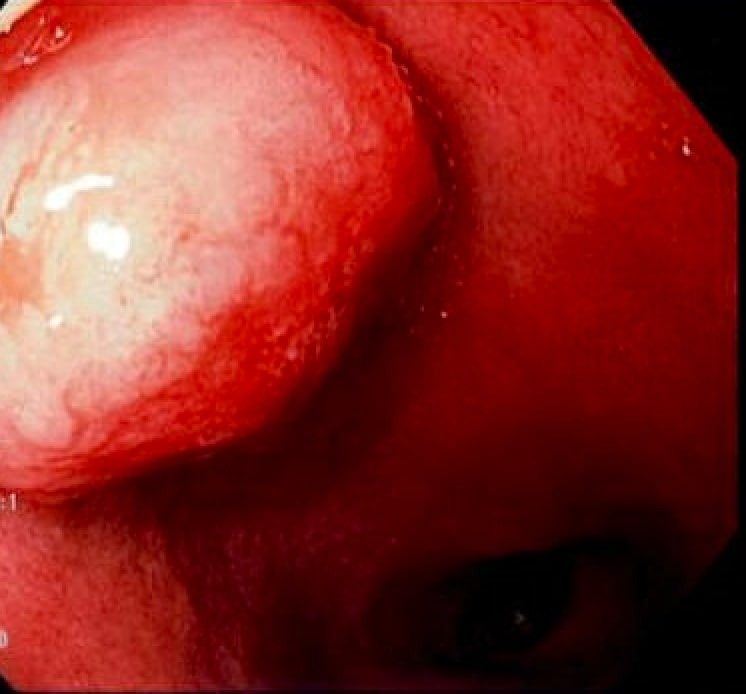Sunday Poster Session
Category: GI Bleeding
P0759 - Duodenal Neuroendocrine Tumor Masquerading as Variceal Bleed in a Cirrhotic Patient
Sunday, October 27, 2024
3:30 PM - 7:00 PM ET
Location: Exhibit Hall E

Has Audio

Brandon T. Wiggins, DO, MPH
Ascension Genesys Hospital
Grand Blanc, MI
Presenting Author(s)
Brandon T. Wiggins, DO, MPH1, Mark Rigby, DO2, Fady Banno, MD2, Derek Korte, DO1
1Ascension Genesys Hospital, Grand Blanc, MI; 2Ascension Genesys, Grand Blanc, MI
Introduction: Neuroendocrine tumors (NETs) of the gastrointestinal (GI) tract represent a rare and diverse group of malignancies, with an increasing incidence and prevalence. These tumors originate from the neuroendocrine cells present throughout the GI tract and are known for their variable clinical presentations and indolent nature. NETs are most commonly found in the ileum and the rectum. A significant challenge in the management of NETs lies in their diagnosis, as many patients remain asymptomatic or present with nonspecific symptoms until the disease progresses.
Case Description/Methods: 53 year old female with alcoholic cirrhosis presented with melena. The patient had confusion over the previous 4 days and melena the day before presentation. The patient denied any non-steroidal anti-inflammatory or anticoagulant use and no alcohol in over a month. She had previously drank one bottle of wine daily for 30 years.
The patient was found to have a hemoglobin of 10.9 g/dL and INR of 1.94 with stable vital signs. Ultrasound of the abdomen demonstrated a cirrhotic liver cirrhosis. The patient was started on IV protonix, octreotide, and meropenem.
EGD was pursued and demonstrated small, non-bleeding varices, mild portal hypertensive gastropathy and a 3 cm submucosal mass in the duodenal bulb with an adherent clot, deemed to be the source of bleeding. Irrigation to remove the clot was unsuccessful.
CT of the abdomen revealed a hyperdense submucosal mass in the duodenum. An endoscopic ultrasound was then performed showing a duodenal mass originating from the 2nd layer, consistent with deep mucosa. Biopsies revealed a neuroendocrine tumor. The patient’s upper GI bleeding resolved and she was discharged home.
Discussion: NETs are a rare type of tumor accounting for 2% of malignant tumors in the GI tract. Duodenal NETs are more infrequent with an incidence of 2-3% of all NETs. NETs are epithelial in nature with neuroendocrine differentiation.
Clinical manifestations of dNETs are insidious and usually asymptomatic. As tumor grows, patients may have fatigue, abdominal pain, and bleeding. However, due to variability of location and production of hormones, presentations of NETs can vary widely.
Management of dNETs are decided based upon tumor size, grade, stage, location and type. Lesions < 1cm in size are able to be resected endoscopically, while larger ones require surgery.
This case is unique, as a thorough literature search was unable to identify any cases of a NET presenting with bleeding.

Disclosures:
Brandon T. Wiggins, DO, MPH1, Mark Rigby, DO2, Fady Banno, MD2, Derek Korte, DO1. P0759 - Duodenal Neuroendocrine Tumor Masquerading as Variceal Bleed in a Cirrhotic Patient, ACG 2024 Annual Scientific Meeting Abstracts. Philadelphia, PA: American College of Gastroenterology.
1Ascension Genesys Hospital, Grand Blanc, MI; 2Ascension Genesys, Grand Blanc, MI
Introduction: Neuroendocrine tumors (NETs) of the gastrointestinal (GI) tract represent a rare and diverse group of malignancies, with an increasing incidence and prevalence. These tumors originate from the neuroendocrine cells present throughout the GI tract and are known for their variable clinical presentations and indolent nature. NETs are most commonly found in the ileum and the rectum. A significant challenge in the management of NETs lies in their diagnosis, as many patients remain asymptomatic or present with nonspecific symptoms until the disease progresses.
Case Description/Methods: 53 year old female with alcoholic cirrhosis presented with melena. The patient had confusion over the previous 4 days and melena the day before presentation. The patient denied any non-steroidal anti-inflammatory or anticoagulant use and no alcohol in over a month. She had previously drank one bottle of wine daily for 30 years.
The patient was found to have a hemoglobin of 10.9 g/dL and INR of 1.94 with stable vital signs. Ultrasound of the abdomen demonstrated a cirrhotic liver cirrhosis. The patient was started on IV protonix, octreotide, and meropenem.
EGD was pursued and demonstrated small, non-bleeding varices, mild portal hypertensive gastropathy and a 3 cm submucosal mass in the duodenal bulb with an adherent clot, deemed to be the source of bleeding. Irrigation to remove the clot was unsuccessful.
CT of the abdomen revealed a hyperdense submucosal mass in the duodenum. An endoscopic ultrasound was then performed showing a duodenal mass originating from the 2nd layer, consistent with deep mucosa. Biopsies revealed a neuroendocrine tumor. The patient’s upper GI bleeding resolved and she was discharged home.
Discussion: NETs are a rare type of tumor accounting for 2% of malignant tumors in the GI tract. Duodenal NETs are more infrequent with an incidence of 2-3% of all NETs. NETs are epithelial in nature with neuroendocrine differentiation.
Clinical manifestations of dNETs are insidious and usually asymptomatic. As tumor grows, patients may have fatigue, abdominal pain, and bleeding. However, due to variability of location and production of hormones, presentations of NETs can vary widely.
Management of dNETs are decided based upon tumor size, grade, stage, location and type. Lesions < 1cm in size are able to be resected endoscopically, while larger ones require surgery.
This case is unique, as a thorough literature search was unable to identify any cases of a NET presenting with bleeding.

Figure: Duodenal Bulb Neuroendocrine Tumor
Disclosures:
Brandon Wiggins indicated no relevant financial relationships.
Mark Rigby indicated no relevant financial relationships.
Fady Banno indicated no relevant financial relationships.
Derek Korte indicated no relevant financial relationships.
Brandon T. Wiggins, DO, MPH1, Mark Rigby, DO2, Fady Banno, MD2, Derek Korte, DO1. P0759 - Duodenal Neuroendocrine Tumor Masquerading as Variceal Bleed in a Cirrhotic Patient, ACG 2024 Annual Scientific Meeting Abstracts. Philadelphia, PA: American College of Gastroenterology.
